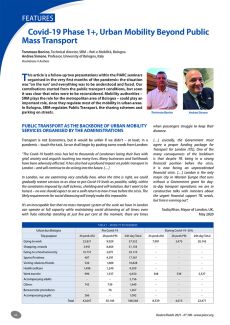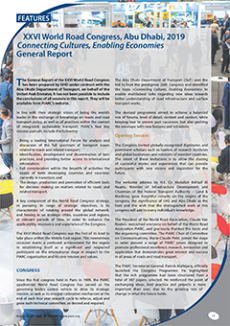Publications Routes/Roads Urban Mobility
This page lists Routes/Roads articles of PIARC in the field of urban mobility. These publications are classified chronologically.
-
Covid-19 Phase 1+, Urban Mobility Beyond Public Mass Transport

This article is a follow-up two presentations within the PIARC seminars organised in the very first months of the pandemic: the situation was “on the run” and everything was to be understood and faced. Our contributions started from the public transport conditions, but soon it was clear that roles were to be reconsidered. Mobility authorities – SRM plays the role for the metropolitan area of Bologna – could play an important role, since they regulate most of the mobility in urban areas. [...]
-
Intelligent Controlled Compact Parking – Pilot implementation of a new parking management for trucks

Due to the enormous increase of commercial freight transport on motorways in Germany it is often problematic for truck drivers to find safe parking places for longer rest periods during the night. Even though expansions have been made to satisfy the demand, overcrowding and dangerous situations still occur as a result of vehicles parking on the entrance and exit roads of rest areas. According to an investigation in 2013 by the Federal Ministry of Transport, Building and Urban Affairs (BMVBS), about [...]
-
XXVI World Road Congress – Abu Dhabi, October 2019 Connecting Cultures, Enabling Economies - General Report

The General Report of the XXVI World Road Congress has been prepared by GHD under contract with the Abu Dhabi Department of Transport, on behalf of the United Arab Emirates. It has not been possible to include the conclusions of all sessions in this report. They will be available from PIARC’s website.
-
Universal Design Project for the Seoul Subway: Development of a Subway Transfer Map for Users with Reduced Mobility

The purpose of this project is to improve accessibility and connectivity of the Seoul subway system for mobility-impaired users through the creation of a transfer map. Users with reduced mobility include those using wheelchairs, buggies, canes or crutches.
-
Achieving Compact Cities Linked by Transit Network in Japan

In Japan, the average birth rate has remained at an extremely low level for a prolonged period. Consequently, the population is shrinking and the elderly population is expected to grow rapidly. In 2010, 23% percent of the Japanese population of was age 65 or older. In 2040, it is expected that 36.1% of the population will be in this age group. Provincial cities are expected to face a rapid population decline in the future, and the populations of prefectural capital cities in particular are expected [...]